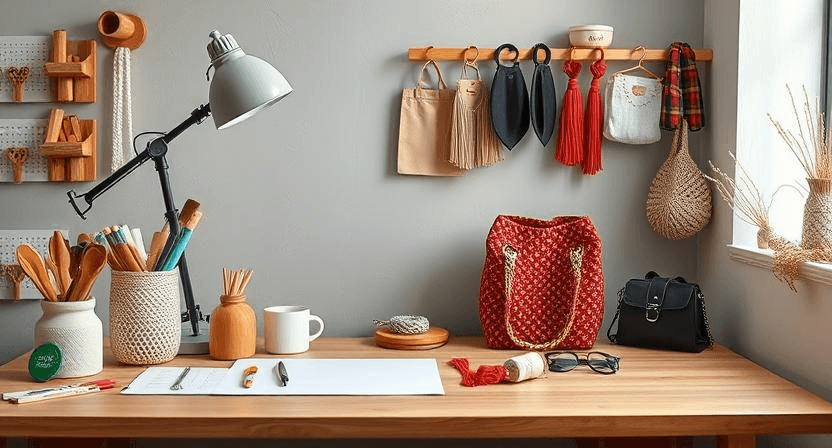Your cart is currently empty!

Sustainable Crafting: How Eco-Friendly Trends are Shaping Handmade Goods in 2025
As sustainability continues to be at the forefront of global conversations, it’s no surprise that eco-friendly trends are making a significant impact on the world of handmade crafts. In 2025, more crafters and artisans are turning to sustainable materials and practices to reduce their environmental footprint while creating beautiful, unique pieces. In this blog post, we explore the top eco-friendly crafting trends for 2025 and how they are transforming handmade goods across various industries.
1. The Rise of Natural and Recycled Materials
In 2025, natural and recycled materials will continue to be the cornerstone of eco-friendly crafting. Crafters are increasingly opting for organic fibers like hemp, linen, and organic cotton, which are not only better for the environment but also add a touch of authenticity and texture to handmade goods. Additionally, recycled materials like paper, glass, and plastic are being creatively repurposed to create stunning products that tell a story of sustainability.
Inspiration: Start incorporating recycled fabrics into your sewing projects or experiment with natural fibers in knitting or crocheting. The beauty of these materials lies in their eco-friendly nature and timeless appeal.
2. Zero-Waste Crafting
Zero-waste crafting is gaining momentum as more people embrace the philosophy of reducing, reusing, and recycling. In 2025, this trend will evolve further, with artisans finding innovative ways to repurpose leftover materials and reduce waste during the crafting process. Whether it’s turning fabric scraps into patchwork quilts or using excess yarn for smaller projects, zero-waste crafting allows crafters to minimize their environmental impact while making the most out of their materials.
Inspiration: Try making small accessories like keychains or bookmarks from fabric scraps or old clothing. These projects are not only eco-friendly but also allow you to create something useful out of leftover materials.
3. Eco-Friendly Paints & Dyes
As more crafters seek to reduce their environmental impact, eco-friendly paints and dyes are becoming increasingly popular. Natural dyes made from plants, fruits, and vegetables are gaining traction, as they are non-toxic and biodegradable. Furthermore, eco-friendly paints, such as water-based and low-VOC paints, are being used in everything from home décor to pottery. These products provide vibrant colors without compromising the planet.
Inspiration: Experiment with natural dyes to color your fabrics, yarn, or even paper. You can create beautiful, earthy tones using materials like turmeric, berries, or coffee grounds.
4. Sustainable Packaging
In 2025, sustainable packaging will become a key focus for crafters who sell their handmade goods. Instead of using plastic or other harmful materials, many artisans are turning to biodegradable, recyclable, or reusable packaging options. Eco-friendly packaging not only reduces waste but also aligns with the values of eco-conscious customers who prioritize sustainability in their purchasing decisions.
Inspiration: If you sell handmade goods, consider using recycled paper, cardboard, or fabric bags to package your products. You can also create reusable packaging that customers can repurpose, reducing their environmental impact.
5. Ethical Production and Fair Trade Practices
Sustainability in crafting extends beyond just materials. Ethical production and fair trade practices are essential components of the eco-friendly movement. Crafters are becoming more mindful of how their products are made, ensuring that artisans are paid fairly for their work and that their practices are socially responsible. This trend emphasizes transparency and accountability, with customers increasingly seeking out handmade goods that support ethical and sustainable production processes.
Inspiration: Look for opportunities to collaborate with artisans from developing regions or support businesses that prioritize fair wages and environmentally friendly practices.
6. Upcycling and Repurposing
Upcycling is a key trend that continues to thrive in 2025. This practice involves taking old or discarded items and transforming them into something new and useful. Whether it’s turning old furniture into stylish home décor, repurposing wine bottles into vases, or using old clothing to create new accessories, upcycling helps reduce waste while giving a fresh life to items that would otherwise be thrown away.
Inspiration: Take a look around your home for items that can be upcycled. Old jars can become beautiful planters, and broken jewelry can be turned into new accessories with a little creativity.
The Future is Eco-Friendly Crafting
Sustainable crafting is more than just a passing trend — it’s a movement that’s reshaping the way we approach handmade goods in 2025 and beyond. By embracing natural materials, zero-waste practices, and ethical production, crafters are leading the way in creating beautiful, eco-conscious products. Whether you’re a DIY enthusiast or a seasoned artisan, incorporating sustainability into your craft projects not only benefits the planet but also opens up a world of creative possibilities. So, let’s continue to create with purpose and passion, and shape a more sustainable future for handmade crafts.